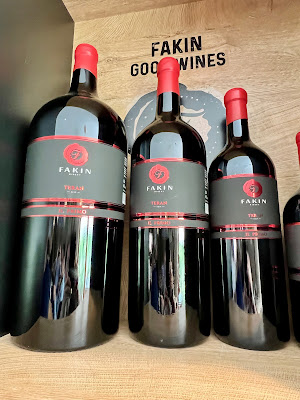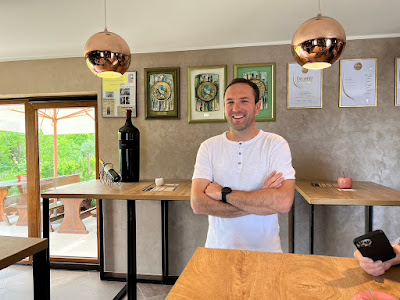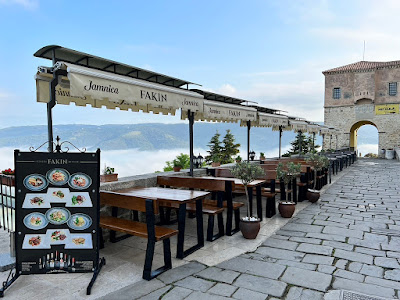We first met Marko in Motovun, and then went with him to visit a couple of his vineyards and then his winery. Overall, I found Marko to be personable and passionate, young and ambitious. He was also down-to-earth, knowledgeable, and very skilled at wine making. He made you feel very welcome.
Marko's family has lived in the same local village for at least 300 years, so his roots in Istria run deep, and his wife was also born in a nearby village. Marko's interest in wine started at a young age. As a small child, Marko would ride on his father's tractor while he worked their small 7.5 acre vineyard. His father sold the grapes to other local producers.
Prior to the Homeland War, his father's vineyard, and others in the region, were part of a cooperative. However, after the War, the cooperative dissolved and the vineyards were split into seven parts, which Vina Fakin would eventually try to purchase.
Marko graduated from wine school around 2010-2011, and he noted that it primarily taught you how to tend a vineyard during good conditions. Thus, you had to learn how to handle problems on your own as they came, gaining experience each year. He also stated that if you make a mistake on year, you have to ensure that you don't repeat it the next year. In winemaking, you only acquire experience once a year, rather than on a constant basis like other professions.
Marko started producing wines in 2010, using grapes from 10 acres of family vineyards, and made about 2000 bottles, 50% Teran and 50% Malvazija Istarska. He sold his wines at local farmers' markets, and used his garage as a tasting room. And he excelled from the start, winning a Croatian wine award for his Teran, and also was recognized as Winemaker of the Year.
Some of his vineyards have vines that are as much as 100 years old, some of the oldest vines in commercial use in the region. They have cut about 70% of the quantity of their red grapes, primarily Teran, to improve its quality. For example, they used to get yields of 5 kilograms but have drastically decreased that amount to 1/2 to 1 kilogram. His wines also have excellent acidity.
The winery produces about 50/50 red and white wines, and it has a capacity of 150,000 bottles, although they only produce about 120,000 bottles currently. He does have plans to construct a new winery, to make it larger. Marko's original plan was to produce only 50,000 bottles, but that has changed, and although Marko claims he is about at his limit now, it's certainly possible he could expand more in the future.
They have 10 labels, mostly Malvazija Istarska and Teran, although they have recently planted Cabernet Sauvignon, Pinot Noir, Merlot and Syrah, to prove they can so. However, they will have to wait 5 years until wines with those grapes will be allowed on the market. One of Marko's goals is to make a "Super Istrian" blend, using Cabernet Sauvignon, Merlot, Syrah and Teran.
Marko also grows numerous olive trees, indigenous Croatian varieties, and produces about 1500 liters of olive oil each year.
As Marko stated, "Teran is his life blood." Teran is not an easy grape to work with, especially in the vineyard, which has caused him to cut down the harvested amounts for extra quality. Marko desires to make a variety of new types of Teran. For example, he wants to make more fresh Terans wines, although this is the hardest style to make as you need to throw out many grapes. He also wants to make Teran wines with longer maceration, such as one year of skin contact.
He currently makes an Amarone-style Teran, commonly with grapes dried on vines, or sometimes on grass mats. He also makes a Teran Rosé. Marko doesn't grow Refosco even though it grows well in the region. Marko also noted that Teran pairs very well with the strong aromas of Istrian truffles.
A big, friendly wine dog!
We toured the winery, and Marko noted that they use French oak as well as Acacia barrels. The winery is small, and compact, so I can understand why Marko wants to construct a new winery, making it more spacious.
Marko sometimes uses amphora, mostly for whites grapes (although sometimes red), producing interesting amber/orange wines.
In their tasting room, we sampled the 2018 Fakin Teran "Michel," a limited edition red wine (of only 1200 bottles) made in an Amarone style. This is their most expensive wine, at 100 Euros, and one of the most expensive Croatian wines I saw in my travels. The grapes came from the Flaminio single vineyard, which was planted in 1972, so the grapes are about 50 years old. The grapes dried on the vine, and had to be hand harvested very quickly.
The grapes spent 50 days with skin contact & fermentation, and then the wine was aged in amphora for a year and then in used barrique for another year. Natural yeast was used, and the shape of the amphora helped to move around the yeast more easily. The wine isn't made very year, and prior vintages included 2011 and 2015, with planned releases for the 2020 and 2021 vintages as well.
With a 16% ABV, this is a big wine, yet not a powerhouse, being very well-balanced. It possesses an alluring aroma of black fruits and mild spice and a dark red, almost purple color. On the palate, it's dry and smooth, with good acidity, rich and complex flavors of ripe plum, black cherry, and blackberry, along with subtle spice notes. It has a long, lingering and pleasing finish, and is considered a young wine which will age very well. I was told that 2027 would be the prime time for drinking this wine. An impressive wine, even in its youth, and clear evidence of Marko's skills, as well as the vast potential of Teran.
I purchased a bottle of this wine, believing it was worth the price, and will let it sit in my cellar, waiting for 2027. Highly recommended, although it would likely be difficult for many people to obtain a bottle of such a limited edition wine.
When we stayed in Motovun, we were a very short walk to Konoba and Enoteka Fakin. The Konoba opened in 2005, and their new chef previously worked at a Michelin star restaurant. They currently have 17 full-time employees at the konoba, and 18 employees at the winery. Marko explained the main difference between a konoba and a restaurant, noting that a konoba served larger portions.
We stopped for lunch at the Konoba Fakin, and had our choice of two dishes. I opted for the Risotto with boletus, black truffles, and Istrian prosciutto chips. What an amazing dish, with perfectly cooked risotto, creamy and flavorful, with earthy notes from the mushrooms and the compelling aromas of the truffles. And those prosciutto chips were crispy, meaty and salty. A well balanced and delicious dish.
The other option was the Fuži pasta with black truffles, which was also quite tasty. This is a common dish in Istria, showing its Italian influences.
With lunch, we enjoyed the 2021 Fakin Malvazija Istarska, with a 13% ABV which only spent 6 months aging in stainless steel. It was fresh and bright, with juicy peach and citrus flavors, a backbone of minerality, and a pleasant finish.
After lunch, we had some free time which I used to further explore Motovun. Later that evening, we returned to Konoba Fakin for dinner, with more truffles and wines.
Dinner began with a glass of the 2019 Fakin Chamal, a sparkling wine made by the Charmat method and with an 11.5% ABV. It's a blend of 80% Malvazija Istarska and 20% Chardonnay, and that blend is how it got its name (CHArdonnay & MALvazija). The grapes were harvested 20 days early to maintain its acidity and lower ABV. It was dry and crisp, with nice flavors of apple and hints of brioche. Easy drinking, and said to pair well with oysters, seafood and pasta. This wine is sold in many Croatian restaurants. Marko noted that Riedel has a specific glass for Malvazija, but it's primarily intended for fresh Malvazija wines.
With an appetizer of scrambled eggs and asparagus, the next wine was the 2019 Fakin Malvazija Istarska La Prima. With a 15% ABV, the Malvazija grapes for this wine were from the Komarso single vineyard, which was planted in 1954. The grapes spent 7 days with skin contact and then was aged for 12 months in acacia barrels. This orange/amber wine had an appealing aroma, and on the palate is was smooth and dry, with a complex and intriguing melange of notes of honey, dried fruits, intriguing spices, minerality and savory elements. Marko stated it was a "fatty wine" that paired well with bitter foods, which would explain its pairing with the asparagus. He also stated he preferred to use a big bowl Burgundian glass for this wine. Highly recommended.
We then moved onto the 2020 Fakin Teran, with a 13.5% ABV and which only 20% of the wine spent a little time in oak. An easy drinking wine, with rich black fruit flavors, spices notes, an elegant of earthiness, and soft, restrained tannins. It can be enjoyed on its own or paired with food, such as spicy manestra, our next course. A fine example of a "fresh" Teran.
Istrian Manestra is the most common dish in Marko's house, a soup (although thicker like a stew) with beans, corns, pork, and vegetables. It's usually served for lunch, a strong meal to fill them up after the work of the morning. This was a hearty and delicious soup, with pieces of crispy prosciutto. A true taste of Istria.
My entree was the Beefsteak with black truffles and mashed potatoes. The meat was tender, juicy and flavorful, enhanced by the alluring aromas of the black truffles. A decadent dish, sure to please any meat lover.
Dinner began with a glass of the 2019 Fakin Chamal, a sparkling wine made by the Charmat method and with an 11.5% ABV. It's a blend of 80% Malvazija Istarska and 20% Chardonnay, and that blend is how it got its name (CHArdonnay & MALvazija). The grapes were harvested 20 days early to maintain its acidity and lower ABV. It was dry and crisp, with nice flavors of apple and hints of brioche. Easy drinking, and said to pair well with oysters, seafood and pasta. This wine is sold in many Croatian restaurants. Marko noted that Riedel has a specific glass for Malvazija, but it's primarily intended for fresh Malvazija wines.
With an appetizer of scrambled eggs and asparagus, the next wine was the 2019 Fakin Malvazija Istarska La Prima. With a 15% ABV, the Malvazija grapes for this wine were from the Komarso single vineyard, which was planted in 1954. The grapes spent 7 days with skin contact and then was aged for 12 months in acacia barrels. This orange/amber wine had an appealing aroma, and on the palate is was smooth and dry, with a complex and intriguing melange of notes of honey, dried fruits, intriguing spices, minerality and savory elements. Marko stated it was a "fatty wine" that paired well with bitter foods, which would explain its pairing with the asparagus. He also stated he preferred to use a big bowl Burgundian glass for this wine. Highly recommended.
We then moved onto the 2020 Fakin Teran, with a 13.5% ABV and which only 20% of the wine spent a little time in oak. An easy drinking wine, with rich black fruit flavors, spices notes, an elegant of earthiness, and soft, restrained tannins. It can be enjoyed on its own or paired with food, such as spicy manestra, our next course. A fine example of a "fresh" Teran.
Istrian Manestra is the most common dish in Marko's house, a soup (although thicker like a stew) with beans, corns, pork, and vegetables. It's usually served for lunch, a strong meal to fill them up after the work of the morning. This was a hearty and delicious soup, with pieces of crispy prosciutto. A true taste of Istria.
My entree was the Beefsteak with black truffles and mashed potatoes. The meat was tender, juicy and flavorful, enhanced by the alluring aromas of the black truffles. A decadent dish, sure to please any meat lover.
With the beef, we sipped the 2018 Fakin Teran Il Primo, with a 14.5% ABV, from grapes of the Flaminio single vineyard, which were planted in 1972, which spent 21 days with skin contact.. Only 3900 bottles were produced, and the wine spent two years in the barrel, 50% new oak. The wine had an intense fruity aroma, and on the palate it was dark and deep, intense and smooth, but well-balanced too. Ripe plum, black raspberry, deep spices, mineral notes, and a lengthy, satisfying finish. Again, Teran makes an impressive wine, and it's clear that Marko is quite skilled with this Istrian grape. Highly recommended.
Dessert was Home made Ravioli with black truffles, and filled with white chocolate. Another delicious and more unique dish, the truffles certainly elevated it. The chef at Konoba Fakin certainly deserves kudos for his menu.
Dessert was Home made Ravioli with black truffles, and filled with white chocolate. Another delicious and more unique dish, the truffles certainly elevated it. The chef at Konoba Fakin certainly deserves kudos for his menu.
Marko Fakin has certainly earned his excellent reputation as a wine maker, and it's great that he is concentrating his efforts on indigenous grapes, Malvazija Istarska and Teran. His passion for Teran is more than evident, and he is leading the way to show the vast potential of Teran. All wine lovers should learn more about Teran, and sample it if possible. Marko is a leader in the new generation of Croatian wine makers, and it was a pleasure to spend time with him, talking and sampling his wines. If you are in Istria, you definitely should visit his winery and check out his Konoba in Motovun.






























